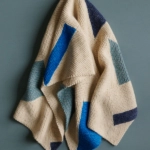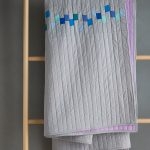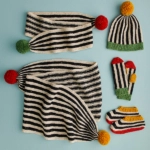Broken Dishes Baby Quilt

I have always loved to make baby gifts, imagining the baby-to-be and anticipating its arrival. Lately this has been particularly true because I myself am expecting my first baby (a girl) this June! After years of crafting gifts for the babies of dear friends and family, I relished the idea of making my own baby something extra special. Of course, a beautiful quilt would be just that!

Picking out the fabric proved to be much easier than I had imagined. I walked into the store one day and there was a stunning rainbow of Japanese yarn dyed linen blend solids, each lovelier than the next! I instantly fell in love and bought a piece of every single color.

Using the traditional “broken dishes” pattern, I approached my work with a sense of unhurried improvisation, putting the blocks next to one another randomly and then rearranging them as I saw fit. It felt more like flower arranging than sewing, and I loved seeing my quilt grow at about the same pace I did! Once the quilt top was finished, I decided that the slow process of hand quilting it would give me plenty of time to daydream about its recipient.

It took me almost the whole length of my pregnancy to create this quilt, but if you’d like to make your own, it doesn’t have to be such a major commitment. Machine quilting and pin basting would go a lot quicker. But then again there is something lovely and very rewarding about not rushing certain projects. Kind of like growing a baby!
ps- This quilt can be made in any color palate imaginable using any quiltweight fabric. The Linen Blend Solids used in this quilt have unfortunately been discontinued but the opportunity has us dreaming of using our Watercolor Linen or even Kona Cotton for some gorgeous color options! Also, The pretty stuffed swan in the pictures above was made by the very talented Tamar Mogendorff, you can check out more of her work here.
Materials

- 1/4 yard of nine various dark fabrics. I used the Linen Blend Solids in Brown, Rose, Magenta, Navy, Denim, Violet Grey, Light Blue, Lavender, and Black. (If you’d like to use fewer dark fabrics you will need 1 1/2 yards total, but if you’re using 1/4-yard pieces you’ll need eight total pieces because of their thin width)
- 1/2 yard of three light fabrics. I used Linen Blend Solids in Beige, Light Beige, and Yellow. (Again you will need 1 1/2 yards total, but if you’re using 1/4-yard pieces you’ll need eight total pieces.)
- 1/2 yard of fabric for the binding. I used the Brown Linen Blend Solid.
- 1 1/4 yards of fabric for the backing. I used the Light Beige Linen Blend Solid.
- A crib sized request weight batting.
- Neutral colored 100% cotton thread. I used color 3260
- If you will be hand quilting your quit you will also want to get Hand Quilting Thread. I used color 0928.
The Linen Blend Solids are, sadly, no longer available. However, the beauty of this pattern is that it will work with any quilt weight fabric. For a brighter version you might want to use Kona Cotton, for richer more jewel toned take on pure linen fabrics you might want to try our Watercolor Linen.
Also, if you are planning on hand quilting please check out the “Materials” section of this previous story. (Hand Quilting uses a lot of tools.)
Size
40-inches square
Pattern
Cutting
Put aside your backing and binding fabrics.
Keep your light and dark fabrics separate.
From a pleasing assortment of the dark fabrics cut:
- At least fifty 5 1/4-inch squares. You will probably want to cut five or ten more squares than you need so that you can have some room to play (and mess up!)
From a pleasing assortment of the light fabrics cut:
- At least fifty 5 1/4-inch squares. (Again, you will probably want to cut five or ten more squares than you need.)

Cut each square diagonally in both directions thus yielding four small right triangles. You will have (at least) 200 dark triangles and 200 light triangles.
Sewing the Blocks
You’ll be sewing one hundred 4-inch blocks total. When sewing this many pieces the best thing to do is to chain piece. Do this by sewing each piece one after another without lifting up your sewing machine foot and then cutting the thread between them apart after you’re done with the whole lot.

Pin each light triangle to a dark triangle along one of the short sides. Keep all the triangle pairs facing the same direction, with the light triangle on the top. This will make it easier to piece them together into blocks later. To make the finished quilt look a bit more random feel free to pin a few dark on dark pairs and light on light pairs together.

Chain piece the triangle pairs together along their pinned sides.

Press each sewn piece open with the seam allowance pressed towards the dark fabric. You now have a larger right triangle

Each block is made out of two of these larger right triangles sewn together along their long sides. The seam allowances should be facing in opposite directions as shown above.

Pin each sewn triangle piece to another one, right sides together, along their long sides paying special attention to lining up the center seams and mixing up the colors. Chain piece these pairs together and snip them apart.

Press the blocks open. You’ll have to press the seams randomly to one side or another because there is no one dark side.
Sewing the Blocks Together

You should have at least 100 blocks. (It’s great if you have more!)
You’ll be sewing together strips of five blocks to start (shown in the diagram above) and then sewing five of these strips together into quadrants of 25-total blocks (shown in the diagram below.) You can either piece the strips and then lay out the quadrant or arrange the whole quadrant and piece the strips from that.
To sew the strips: Sew five blocks together, one after another in a pleasing arrangement. Don’t worry about the blocks facing the same way, it will look nicer if they don’t. Repeat five times so that you have five strips.

Sew the five strips together along their long sides paying very close attention to matching up the seams of the blocks together. Your seam allowances are going to get a little crazy at this point especially at the corners so make sure to use a lot of pins, sew slowly over them, and try to iron them in one direction consistently once they’re sewn. This group of 25 blocks is one quadrant.
Repeat this to make three more quadrants.

Arrange the quadrants so that you like the way they look. Sew the top two quadrants together and then sew the bottom two quadrants together. Then sew the top and bottom together. Again, pay very close attention to matching up the corners of each block.
Your quilt top is done!
Quilting and Binding

How you finish your quilt is up to you. If you have never hand quilted anything before this might not be the best project to start with because it’s a bit thick in places due to all of the seam allowances.
For a refresher on Hand Quilting you might want to check out out Hand Quilting Tutorial here.
If you’d like to machine quilt it our Courthouse Steps Mini Quilt Project goes through that process in depth (scroll down to the bottom.)
Or for an even quicker way to quilt, you could tie it. For that process check out our Tied Quilting Tutorial here.
You can also check out our Quilt Finishing Tutorials for ways to bind it.
However you choose to finish your quilt I hope you have as much fun making it as I did!





Congratulations! What a beautiful way to welcome your new baby. Such a soft-toned yet graphically striking quilt.
Every time I see something this lovely that's quilted I makes me want to learn to quilt. I will learn to quilt this year, that's a promise!
So pretty! Congratulations! I'm inspired to do something like this for my little bun in the oven 🙂
I haven't quilted in years… not since I first learned which was probably 20 years ago now, but this project is so inspiring. I feel compelled to give it another try.
Thank you for sharing!
what a beautiful project! i'd love to make something similar for my best friend who's pregnant and i have a question: can the hand quilting be made with the stitching machine?
thanks and keep those projects coming!
Hi Josep-
You can quilt it on a sewing machine. There are links to all the different quilting options in the “Quilting and Binding” section of the story above.
Thank you for writing in!
Molly
Hey Molly,
I was hoping you might know how a beginniner quilter would modify this quilt to make it for a double size bed? How much fabric I would need and such? Thanks for any help!
Hi Miss Criss-
For a double sized quilt I would get 6 yards of fabric for the quilt top (you'll have some left over but it's better to have too much than too little). So that's 3 yards of light fabrics and 3 yards of dark fabrics. You will need 5 yards of 45-inch wide fabric for the backing. And 3/4 of a yard for the binding.
A double quilt should be about 72 X 90-inches. To make it larger you can either make more 4-inch blocks or make each block larger. If you want to make more blocks that would mean sewing 414 four inch blocks total. The final quilt would be 18 squares wide by 23 squares long.
Or, the easier way to do it would be to make each block larger. I would suggest making 8-inch blocks instead of 4-inch blocks. To do this cut your initial square pieces (in the section of the pattern entitled “cutting”) 9 1/4-inches. Cut at least 54 from the lights and 54 from the darks and then follow the rest of the directions as listed. You will need at least 108 blocks total. The final quilt would be 9 blocks wide by 12 blocks long.
Please let us know if you have any other questions.
Best- Molly
Hi Molly –
This is a beautiful quilt and has inspired me to do something similar for my coming bub. Just want to know – do you machine wash and dry this quilt?
Thanks,
Gillian
Hi Gillian-
You can wash and dry it in the machine. It will pucker up a little bit but I think that adds to the beauty.
Thank you for your question!
Molly
Hi Molly, so the fabrics are not prewashed before quilting? I am planning to make a similar quilt with Purl Soho Handkerchief and Watercolor Linens. Thanks!
Hi Laurel,
Thanks for reaching out! Yes, that is correct! Molly did not prewash her fabrics, so when the finished quilt was washed and dryed, they shrunk slightly to create a more vintage-looking puckered surface. I think this quilt would be absolutely lovely in linen!
Best,
Julianna
congratulations on both your wee one and this beautiful quilt! A good friend of mine showed me this and it led me to make my own; what fun!
Hello, did you use quarter inch seams on this quilt? That is what I assume but figured I should ask! Thank you
Rachele. Great question! Yes, Molly used 1/4 inch seams! -Laura
I'm about to get started on this as my first quilt, and I'd like to hand-quilt the layers together but have two of questions:
I loved your hand-quilting tutorial, but I'm confused on where to quilt the layers together with the broken dishes pattern. It doesn't seem like the parallel lines in the other tutorial would work here, and it seems like you must have stitched along some of the triangles' edges. Is that right, and how did you decide where to?
I'm also a little confused on how the back of this broken dishes quilt should look. I'm afraid if I just wing it, the top will look great but the back could look like a mess. Do you have any tips for a beginner?
Thank you so much!
I actually had the same question as above on hand-stitching this type of pattern.
Did you stick to the “stitching in the ditch”? And did you use that same 0928 color thread throughout for hand stitching?
Hi Stephanie.
Sorry for the delayed response. The blanket is at home with new-mom Molly who is on maternity leave. But we talked with Molly and the quilting is done with that same 0928 Hand Quilting thread (https://www.purlsoho.com/purl/products/item/6356-Gutermann-Hand-Quilting-Thread). It is not stitched “in the ditch”, but rather… near the ditch or right next to the ditch.
Hope this helps.
Thanks for commenting.
Laura
What a lovely quilt. In my family grandma and aunts-to-be have worked together on quilts for eight cousins. My sister once famously stated that she didn't like any “namby-pamby baby stuff.” This quilt certainly wouldn't raise any objections from “baby” as they grow older!
Hi! I love this quilt and plan on making it for my best friends upcoming baby. Do you think I could pick a few fabrics with patterns, but mostly use solids or would that look jumbled?
When hand quilting did you only quilt/stitch on the “light” color? Is it possible to see a photo of what the back looks like? I am to the point of quilting and it would really help me decide how to approach it. Thank you for the beautiful idea!!
Hi Blackwood Batteau-
I did only stitch on the light triangles and unfortunately we don't have a picture of the back.
Good luck with the quilting and thanks for writing in!
Molly
Hi Molly,
I’m late, i’m late… stumbled opan your beautiful Broken Dishes Quilt and have to tell you how much it speaks to me. In my cupboard I have a fatquater bundle of aged muslins. Will give it a try. Thanks for the inspiration.
Kind regards from Switzerland
Hi Ursula-
Thank you so much! I’m so glad this inspired you!
Molly
Hi! What a beautiful blanket that I would love to make. I see that this fabric is no longer available though. Do you have an alternate fabric suggestions?
Thank you,
Marissa
Hi Marissa,
Thanks for reaching out! Our Watercolor Linen comes in a beautiful array of yarn dyed colors that would work wonderfully in this quilt, and a bundle would be just about perfect for this project!
Happy quilting!
Julianna
I LOVE this and congratulations!! Please tell me where the sewing pattern for this goose /swan is from!
Hi Barbara,
Thanks for writing in – I’m so glad that you love the pattern! We didn’t make that pretty swan, but you can take a look at the website of the talented maker here – Tamar Morgendorff
Best,
Cassandra
Hello! I adore this quilt and I’m looking forward to making it soon. I’m wondering if you have the measurements & square count to make a throw? I’d like the coming baby to be able to grow with it and have it for a long time 🙂 thank you!
Hi Kelly,
Thanks for reaching out! Unfortunately this pattern is only available in the one size, but thank you for your interest and I will be sure to pass this along! I think it would be fairly easy to adjust the pattern to get a larger size. Since it is a 40″x40″ square you could add another row or two of the triangle along horizontally and vertically to achieve a larger size!
Let us know how this works out and if you have any more questions moving forward please feel free to reach out!
Gianna